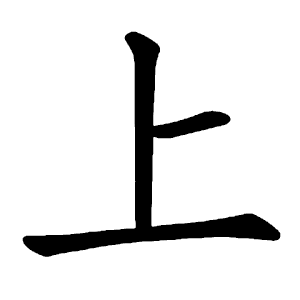上
- up;
- top;
- first;
- best;
Etymology
Early forms show a long horizontal line (一, the ground) with a shorter stroke or dot placed above it, denoting “that which is higher.”
Over time, the form standardized into 上. It is the natural counterpart of 下 (“below”).
Semantic range:
- above, on top of (위, 상단);
- to rise, to go up, to ascend (오르다, 올라가다);
- superior, higher in status, earlier in order (우위, 상급, 상위);
- beginning, former, previous (처음, 지난);
- used as a prefix in compounds (上級, 上等);
Usage in Korean
上下 (상하) — up and down; superior and subordinate
上品 (상품) — superior quality
上手 (상수) — skillful person
上京 (상경) — going to the capital
上帝 (상제) — God, the Supreme Deity
以上 (이상) — above, over; “that is all”
上善若水 (상선약수) — “The highest goodness is like water” (Dao De Jing)
Words that derived from 上
- 막상막하(莫上莫下)–almost equal
- 사상(史上)–being in history
- 상(上)–good; top
- 상고(上告)–appeal to a higher court
- 상관(上官)–superior; boss
- 상기(上記)–the above; being aforementioned
- 상륙(上陸)–landing; introduce
- 상병(上兵)–corporal
- 상의(上衣)–top
- 상품(上品)–good product
- 상하(上下)–top and bottom; superiors and inferiors; the upper and lower classes; high and low; high quality and low quality; increase and decrease; the first and second volumes
- 세상(世上)–world; world outside; secular world; life; being really; being never
- 수상(水上)–water way; being on the water; upstream; upriver
- 이상(以上)–or more; and over; now that; since; the end
- 정상(頂上)–peak; top; leader
- 조상(祖上)–ancestor; ancestry
- 천상(天上)–celestial; heaven
Additional notes
In Confucian thought, 上 often denotes the ruler, authority, or the morally superior position, contrasted with 下, the people or subordinates. The phrase 上下有序 (“there is order between above and below”) reflects the Confucian vision of a well-ordered hierarchy.
In Daoism, 上 is ambivalent—while “high” status can imply honor, Laozi often stresses that the truly great (上善) resembles water, which seeks the lowest places. Thus Daoist wisdom often subverts the ordinary preference for “above.”
上 resonates with the Christian image of God as the Most High (Psalm 57:2) and Heaven as “above.” Christ’s ascension (升天) is central to Christian faith, symbolizing exaltation after humility. Yet in Christian paradox, true exaltation (上) comes only through humility (下): “Whoever exalts himself will be humbled, and whoever humbles himself will be exalted” (Matthew 23:12). Thus 上 and 下 together embody the rhythm of descent and ascent in Christian theology.
